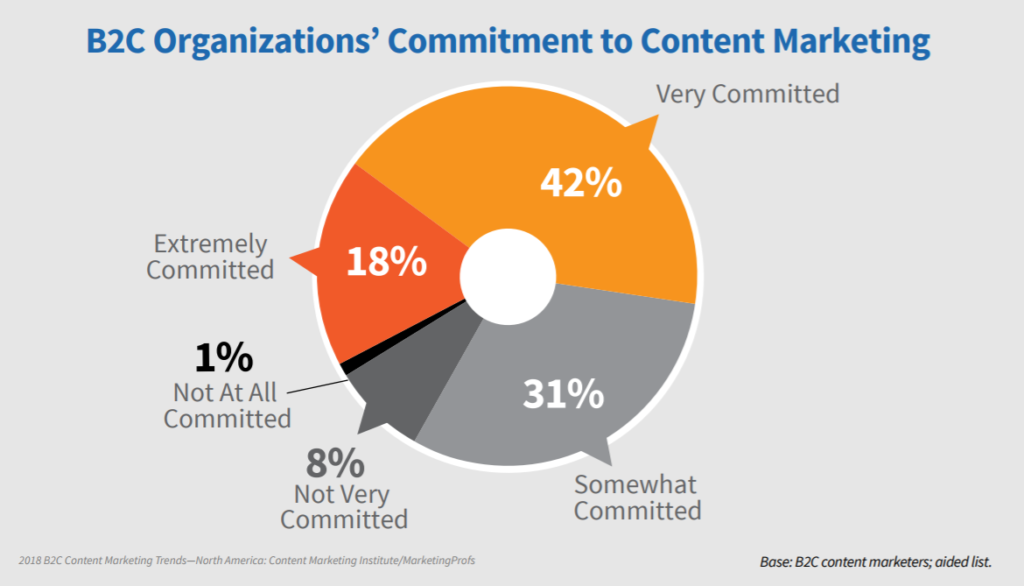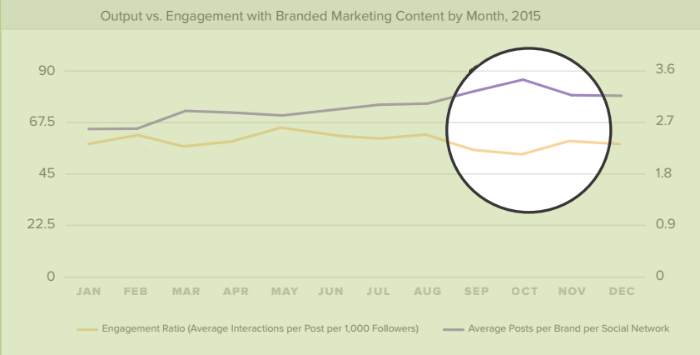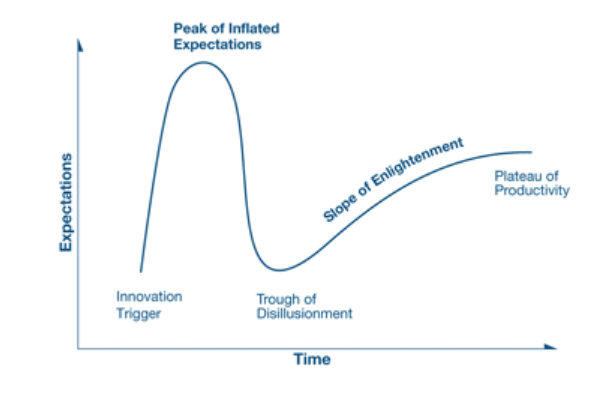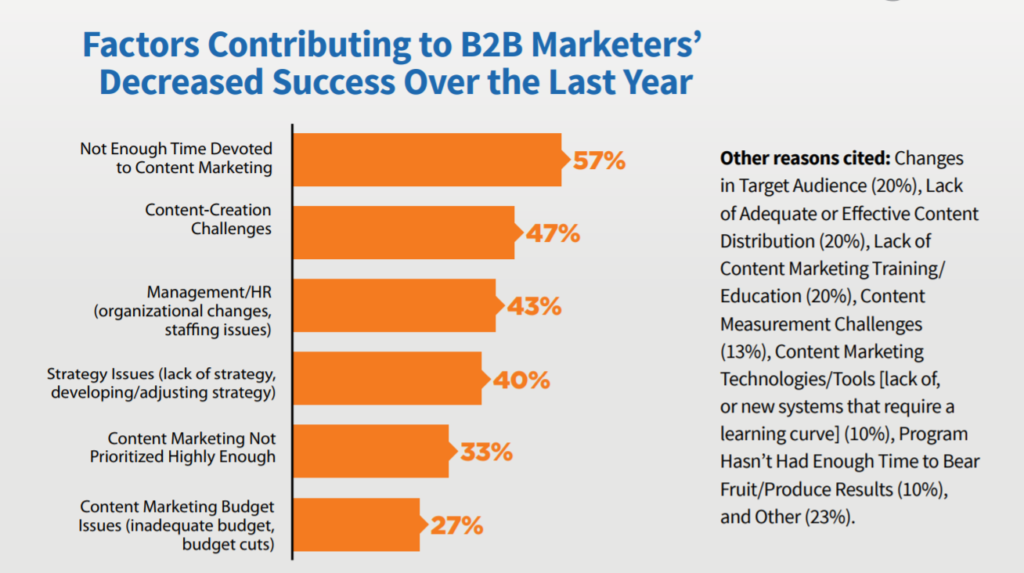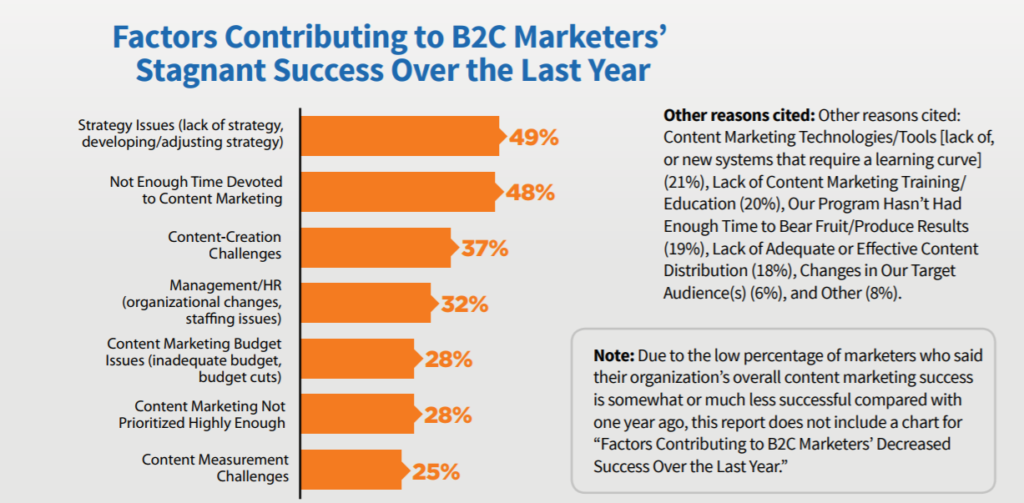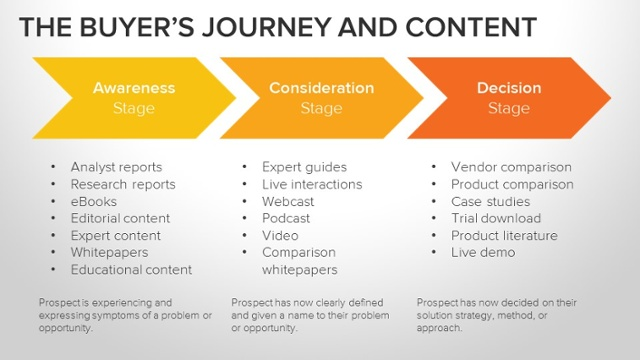When you’ve been in the digital marketing space for more than 12 years, you see a lot of trends come and go in that time.
Remember back in 2006, when all it took to rank a website was a few low-quality backlinks and some spun content?
SEO has, obviously, evolved since then, and I believe we’re likely to see a similar shift in 2018 with content marketing.
What got you to the top in 2017 won’t get you there in 2018 – but that doesn’t mean content isn’t a worthwhile investment anymore.
Here, I’ll break down why your 2017 content strategy won’t work going forward, as well as the steps you need to take to protect your future profits in this shifting landscape.
Content Marketing: Where We Are Now
The key to understanding the future of content marketing is recognising that it’s no longer the web’s “hot, new” tactic.
Although some people trace the origins of content marketing back to Poor Richard’s Almanac, published by Benjamin Franklin in 1732, the term was first used in the context of digital marketing by Penton Custom Media out of Cleveland, Ohio in 2001.
In the 16 years since, content marketing has become ubiquitous.
According to the Content Marketing Institute’s annual Benchmark, Budgets and Trends report, 91% of B2B respondents to the company’s 2018 survey currently use content marketing.
Of the 9% of participants that don’t, 54% plan to launch a content strategy in 2018.
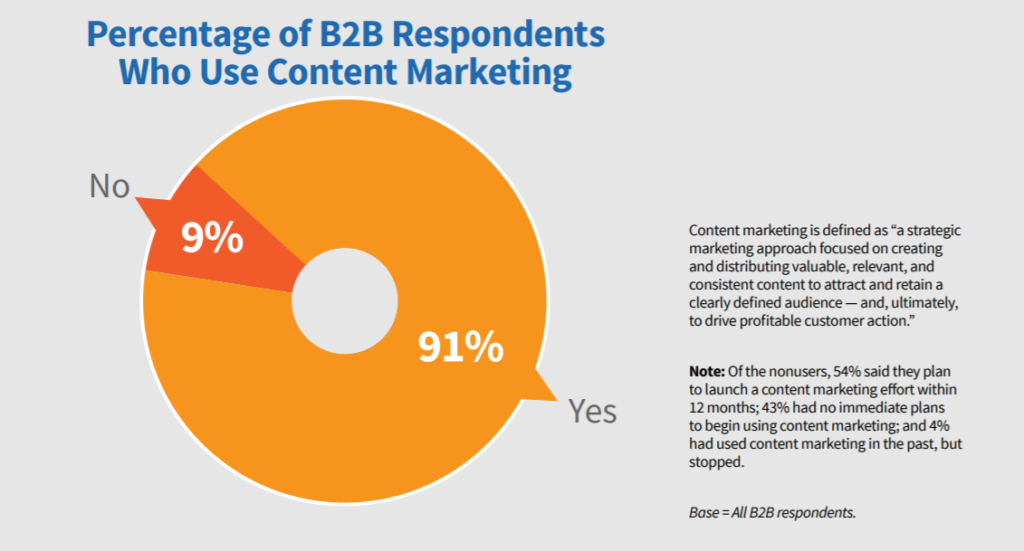
On the B2C side, 86% of 2018 survey respondents report using content marketing.
All but 9% of these participants identify themselves as “somewhat committed,” “very committed” or “extremely committed” to the success of their content.
The size and scope of some of these investments is massive.
As Gary Henderson shares in a Forbes article:
“Apple recently committed to spending $1 billion on original content for its streaming platform. PepsiCo opened a brand new content creation studio in downtown NYC with the aim of generating revenue and creating a vehicle for advertising their products.”
Everyone – from SMBs to enterprise companies (and everything in between) – is investing in content marketing.
But as they do so, they’re running into a problem.
The Diminishing Returns of Content
Back in 2015, TrackMaven identified a trend suggesting that companies were publishing more content, but getting a smaller result: what it calls the “content marketing paradox.”
According to the company’s data:
“In 2015 alone, the output of content per brand per channel increased by 35 percent, but engagement fell by 17 percent.”
It’s an understandable result.
As more and more companies have gone all-in on content, they’ve flooded their channels with so much information that it’s hard for consumers to differentiate one brand’s information from another – let alone engage with all of them.
In fact, the space has gotten so competitive that the average consumer is exposed to more than 10,000 brand messages per day, per the American Marketing Association.
The challenge there is obvious – but it also points to a larger, more looming threat to content marketing.
The End of the Content Marketing Hype Cycle
According to Gartner, it’s possible to differentiate bold tech claims from those that are actually commercially viable using a modeling process called the Hype Cycle.
“Gartner Hype Cycles provide a graphic representation of the maturity and adoption of technologies and applications, and how they are potentially relevant to solving real business problems and exploiting new opportunities.”
Hype Cycles have five stages:
Basically, when new technology is triggered, it moves through a period of inflated expectations, before falling off a cliff into what Gartner calls the “trough of disillusionment.”
After that crash, the actual benefits of the technology start to crystallize (through the “slope of enlightenment”) and enjoy slower, but steadier growth through the “plateau of productivity.”
Content Marketing Institute’s founder, Joe Pulizzi, believes we’ve just about reached the “peak of inflated expectations” when it comes to content marketing.
He predicts:
“After hitting the big peak, we slide into the trough of disillusionment. It’s the moment when all those who tried the shiny new thing realize it’s not so easy. This is where we are heading now as content marketers.”
Though Pulizzi made that prediction back in 2016, I’d argue that we haven’t yet begun the downward slide into disillusionment.
But we’re close.
In my work at Louder, the most common questions I used to hear about content marketing were “why should we do content marketing?” and “how do we get started?”
Now, I’m hearing hesitation.
People know what content marketing is now; their introductory questions are out of the way.
What they struggle to see are the benefits of investing in the strategy – which, when you consider the challenges facing it, is understandable.
The Challenges of Content Marketing
The 2017 edition of the Content Marketing Institute’s B2B Benchmarks, Budgets and Trends report reveals twelve separate sources of challenge impeding campaign success:
The corresponding B2C report revealed similar challenges leading to stagnating levels of success in 2017.
Though this information does not appear to have been included in the company’s 2018 reports, these challenges will be familiar to anyone who’s struggled with content marketing effectiveness.
Not having enough time to devote to content marketing, challenges when it comes to creating content and the ongoing struggle associated with measuring results are all common complaints from people who were sold content marketing as a “shiny, new” thing, and are now running head-first into its competitive landscape.
It’s this growing realisation of content marketing’s limitations that leads me to believe we’re nearing the “trough of disillusionment.”
But where some marketers might see this as a doom and gloom prediction, I see opportunity.
As the diminishing returns and ongoing challenges associated with content marketing continue driving us over this peak, more and more companies will drop their investments in the strategy.
As they exit the market, opportunities to capture attention with content open up – that is, if you can adopt the strategies necessary for surviving in the “slope of enlightenment” we’ll see in 2018 and going forward.
What Will Content Marketing Look Like in the Future?
Breaking down the key challenges currently affecting content marketing reveals opportunities to drive better results.
Specifically, let’s look at two of the primary challenges affecting content performance: content that doesn’t reach consumers, and content that doesn’t produce business results.
Content That Doesn’t Reach Consumers
Failing to reach consumers isn’t a singular issue, and it isn’t solely attributable to the increasing levels of competition I described earlier.
In fact, content can miss consumers for a number of different reasons:
- It isn’t optimized for search
- It’s delivered on a channel where target consumers aren’t active
- It’s filtered out of these channels by algorithms that favor paid advertisers (see Facebook’s dismal organic reach for evidence)
- It isn’t presented in a way that’s engaging enough to consumers to earn their attention
- It’s delivered in a format your target customers don’t care for
Say you publish a post to your company blog.
Regular readers (if you have those at all) might find it, but the odds of a new prospect stumbling across it at random are quite small.
That’s especially true if you haven’t optimised your content according to current SEO best practices in order to drive engagement through organic search.
So maybe you decide to share your new article to your company’s Facebook profile.
Again, a small fraction of your followers might see it, but it’ll largely go missed by your fans (let alone the general public).
Even Facebook acknowledges that, “Of the 1,500+ stories a person might see whenever they log onto Facebook, News Feed displays approximately 300.”
If you aren’t one of the lucky few, you can kiss connecting consumers with your content goodbye.
Next up, you decide to share your new article via email.
Bad news again, according to Lifewire’s Heinz Tschabitscher:
“Statistics, extrapolations, and counting by the Radicati Group in February 2017 estimated the number of email accounts worldwide at 3.7 billion and projected that the number of emails sent per day in 2017 averaged a staggering 269 billion.”
If you aren’t able to come up with a winning subject line that drives email opens (or, if you aren’t able to keep your messages from hitting your recipients’ filtered inboxes or spam folders), you’re out of luck again.
Now, finally, suppose you’re one of the lucky ones.
You get your new blog post in front of your target customer, whether through your website, social profile, email marketing campaign or other channel.
But what if your prospects don’t want to read blog posts?
What if they’re really only willing to engage with video content?
Again, the opportunity to connect with your customers via content slips through your fingers.
Before we start extrapolating what content marketing will look like in the future, based on these challenges, let’s cover the flip side of the equation:
Content That Doesn’t Produce Business Results
Getting your content to your target customers is only half the battle.
If the content you’ve produced doesn’t prompt them to some sort of action – even if that action is something as simple as thinking of your company in a more positive light – you’ve wasted the spend on that piece of content.
Unfortunately, there are plenty of reasons content fails to drive business results:
- Your customers don’t care about your content
- It’s targeted to your needs – not your customers’
- It’s poorly targeted to your prospects’ stage in the buyer journey
- You don’t include a compelling ask
One of the biggest problems I see when I talk to companies that are frustrated with their content marketing results is that all the content they’ve generated serves their needs – not their customers’.
Imagine landing on a business blog that’s full of what are, effectively, sales pitches.
Maybe they’re done with some subtlety, under the guise of giving behind-the-scenes looks or offering tutorials on how to get the most out of the company’s products.
But more often that not, there’s no nuance – they’re just outright sales pitches, bragging about the company’s products or successes.
Consumers don’t want that.
They want to be educated.
They want to be entertained.
And more than anything, they want to know how you’re going to solve the problems they’re experiencing.
Content can do that – but only if you approach it the right way.
Part of that involves understanding how your content supports consumers on their buyer journeys.
One of the biggest shifts I believe we’ll see in content marketing over the next few years is an increased focus on tying individual content pieces to buying cycle stages.
Let’s review for a moment…
When consumers are thinking about making a purchase decision, they go through distinct stages, including:
- Awareness of a need
- Consideration of alternatives
- Evaluation and selection
What more and more marketers are getting wise to is the fact that prospects’ content needs are different at each of these stages.
So if, like most companies, you only focus on developing top-of-funnel content designed to grow awareness of your brand, you’re missing out on potential opportunities to use content to convert them into buyers.
As Neil Patel describes:
“Rather than focusing too heavily on top-of-the-funnel content to fuel your customer acquisition, your strategy should switch to supporting every stage of that buyer’s journey. Going forward, your content will need to be more diverse, purposeful, nurturing, and interconnected so it propels the customer forward.”
Into 2018 and beyond, tying the content you create to the needs of prospects at each funnel stage will be a necessary part of marketing success.
Also important?
Asking those who have consumed your content to take some kind of action.
It’s a simple and obvious – yet often overlooked – content challenge.
You can pump out dozens – even hundreds – of blog posts or other content pieces, but if they never ask people to deepen their relationship with your company, they’re never going to drive real business results.
And that’s what we’re all after, isn’t it?
To be clear, the “ask” associated with your content doesn’t have to be a potential purchase.
You might use it to ask prospects to pull out their wallet, but you might also ask them for:
- A comment
- A social share
- A newsletter opt-in (often in exchange for a relevant lead magnet, like a content upgrade)
- A lead generation form-fill
Each of these calls-to-action, among others, helps prospects become more comfortable with the idea of engaging with your company.
String enough of them together – keeping the suggestions above in mind as well – and you’ve got a winning recipe for content success.
To be clear, these aren’t exclusive lists.
Poor content marketing performance can occur for many additional reasons beyond those described here.
But hopefully, they should start to illustrate some of the reasons why content campaigns are successful (and why others fall flat).
Now, let’s tie it all together into a comprehensive marketing plan for 2018 and beyond.
Your 2018 Content Marketing Plan
Knowing what we now know about the future of content marketing, here’s how to move forward with a comprehensive strategy.
Get the Fundamentals Right
Many of the best practices that have been associated with content marketing since its inception are still valid.
Too often, though, marketers who are in a rush to launch content so they can say they’ve done so skip them – generally, with disastrous results.
As the challenges above emphasise, there’s no getting around the need for the following fundamentals:
- A complete understanding of your target buyer persona (including their demographics, psychographics and pain points)
- An editorial calendar and strategy plan (35% of marketers who have a documented content strategy are more effective in all aspects of content marketing than those who have not)
- An identified set of content performance metrics to track (along with the analytics systems required to track them)
Beyond that, however, you’ll want to expand your strategy with the following considerations in mind.
Test Different Content Formats
Remember earlier, when I described web users who would rather watch video than read articles?
The only way you’ll know – conclusively – what type of content your prospects prefer is to test different formats and measure their impact.
Thanks to new technology, deploying content in new formats isn’t as difficult as it sounds.
Formats like video and interactive content are now easily accessible to all marketers – no matter your level of technical skill.
Sebastian Bryers, CTO at Ora Organic, suggests in an Inc. article that dynamic content will be an important part of future campaigns:
“A growing number of brands are using this to tell a more authentic story via social media and connect with a base of Millennial consumers on a more personal level to create trust and offer a kind of ‘behind the scenes’ look, if you will.”
Brian Rauschenbach, head of industry at Add3, claims in the same article that video will be non-negotiable for the future of content marketing:
“Video is here to stay, and you won’t be able to compete without it. Facebook and other ad platforms are showing preferences on organic and paid placements because the engagement rates are higher with video content.”
Testing different content formats isn’t just about delivery methods, though.
In addition, you’ll want to test deploying content that requires different levels of investment.
For instance, you might want to experiment with what’s known as “10X content” – that is, content that’s 10 times better than what your competitors are offering.
Figure out where the bar is currently set by researching your competitors’ top performing content using a tool like BuzzSumo.
Then, look for opportunities to beat their efforts by addressing gaps in existing content, or by expanding on their work to create something more thorough or actionable.
Get More Out of Individual Content Pieces
One way to maximise the ROI of your content campaigns is to get more use out of individual content pieces.
If you write a single blog post, for example, turning it into a video, releasing it as an audio recording and sending it out as an email newsletter should get you more sales without a corresponding increase in effort.
However, getting the biggest possible impact from your individual content pieces isn’t just about repurposing them or deploying them on multiple channels (though these strategies are worthwhile).
One concept I expect to gain ground in the future is the idea of content clusters.
Hubspot’s Matt Barby gives the formal definition of content clusters (or topic clusters) as follows:
“In simpler terms, a pillar page is a broad overview of a specific topic. You can think of it like a summary or road map. Linking into the pillar content is a range of content that covers individual, more specific subtopics, otherwise known as cluster content. Each cluster topic page for the pillar focuses on providing more detail for a specific long-tail keyword related to the main topic. The pillar links to each cluster page and each cluster page links back to the pillar with the same hyperlinked keyword.”
Not only is the concept of a content cluster beneficial from an SEO perspective, it minimises the research time required to put out content.
Better SEO. Less content effort.
Make sure this strategy is a part of your 2018 content marketing campaigns.
Invest in Content Promotion
Want a simple way to improve the effectiveness of your 2018 content marketing efforts?
Take half the budget you were planning to spend on content creation and invest it in promotion.
Derek Halpern’s suggestion to spend 80% of your time promoting content, relative to just 20% spent creating it, isn’t new.
However, it’s increasingly important, given the growing challenge of getting content in front of the right people.
Quite frankly, it’s unreasonable to expect that all companies – across all industries – will begin pumping the brakes on content promotion.
So even if some players begin dropping out of the market, we’re likely to experience crowded, competitive conditions for the foreseeable future.
That makes content promotion critical for future campaign success.
Any of the following tactics, among others, could be useful in planning your promotional strategies:
- Paid social media advertisements
- Paid search and display PPC ads
- Paid placements in email newsletters
- Native advertising
- Programmatic advertising
- Organic or paid influencer marketing
- Cold email outreach
- Broken link building
- Guest publishing and content syndication
- Publishing to industry-specific forums (such as org or GrowthHackers for marketing content)
- Paid remarketing campaigns
Choose the marketing mix that’s right for you, and make sure you have the necessary mechanisms in place to measure the performance of the individual tactics you’ve chosen.
Move Beyond Marketing
The smartest marketers I know aren’t looking at content marketing as the exclusive domain of a company’s marketing team.
Instead, they’re breaking down silos and looking for ways to integrate content across multiple departments.
For example, content can be a valuable support resource for:
- Customer service reps who answer the same questions over and over
- Sales team members who can use content pieces to overcome objections at all stages of the buying process
- Account reps who can use content to make the onboarding process more scalable
Working cross-departmentally to produce content introduces new challenges to the process, simply by adding new stakeholders.
However, the results can be worth it.
As an example, data shared by Kapost suggests that:
“Companies with strong sales and marketing alignment achieve 20% annual growth rate. Companies with poor sales and marketing alignment have a 4% revenue decline.”
Where else in your company can you apply the insight you’ve gained through content as a marketing initiative?
How can the content you create facilitate the success of other departments?
Those are the kinds of questions forward-thinking marketers will be asking themselves in 2018 and beyond.
Think About Content on a Higher Level
Finally, if you want to really challenge your ideas of what content marketing might look like in the future, give Joe Pulizzi and Robert Rose’s book, Killing Marketing, a look.
In it, the two argue that everything we know about marketing – content marketing included – is wrong, and that, to survive, companies must emulate media companies in the way they engage with prospects and customers.
Will all of their predictions come true?
It’s unlikely, of course (at least, in the short-term).
However, as you’re planning for your success not just in 2018 but in the many years ahead, considering the impact major transitions such as these could have on your business will ensure you’re acting from a proactive – not a reactive – position.
You Won’t Win Content in 2018 with a 2017 Strategy
Ultimately, what the success of future content campaigns comes down to is adapting the tried-and-true best practices to the needs of modern audiences, in the context of modern content landscapes.
Take what’s been proven to work for your company and improve upon it, using the forward-thinking strategy suggestions I’ve shared here.
Keep a careful eye on your results, and iterate as you go.
That’s the true recipe for content success in the coming years.
How are you adjusting your content strategy in 2018 and beyond? Leave me a note below sharing your thoughts:
Header Image Source: MaxPixel




